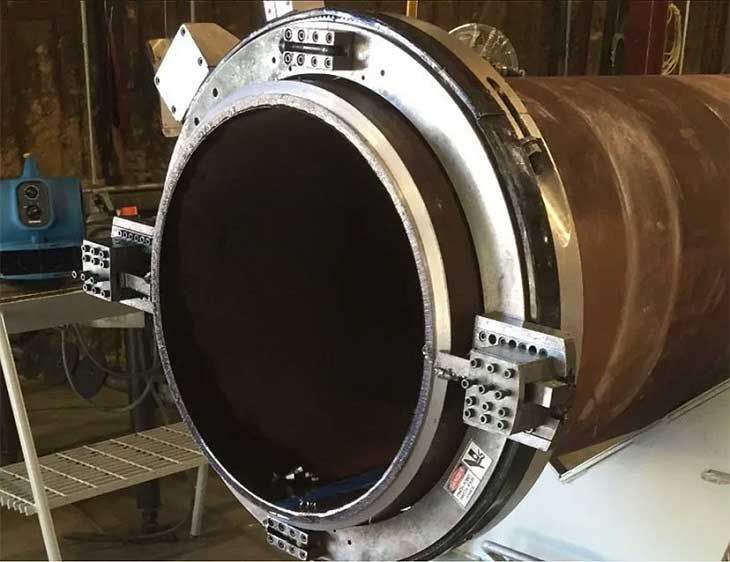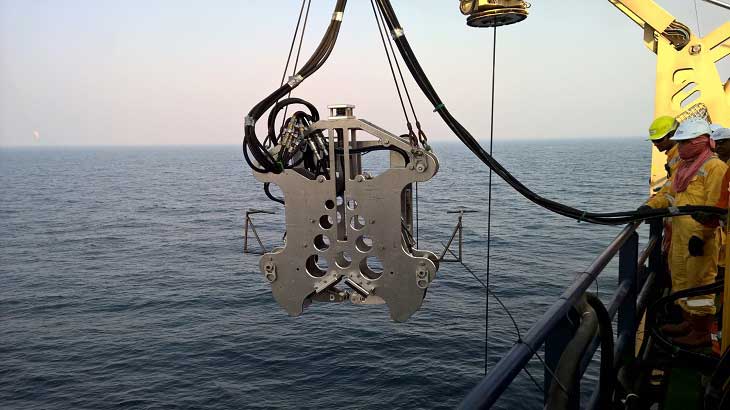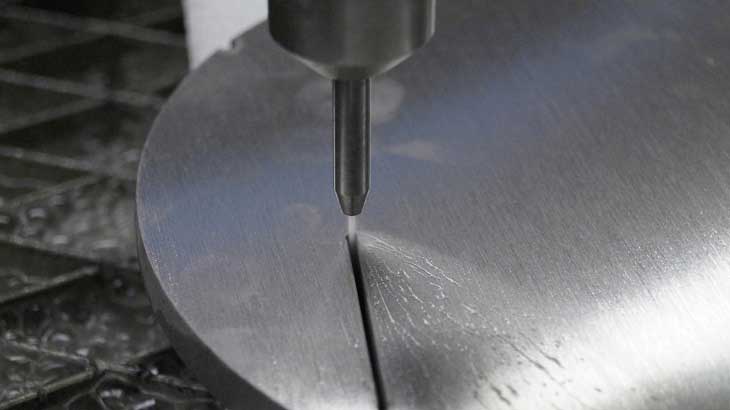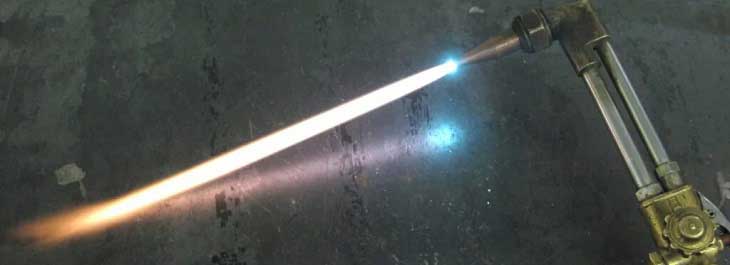What is Cold Cutting?
Cold cutting is a procedure for cutting material without using heat. With no sparks produced, the process is the safest method for cutting structures in hazardous environments. Typical industries where cold cutting takes precedence is the oil and gas and petrochemical industry.
Three commonly used types of cold cutting machines are: pipe cold cutting machines (also known as clamshell cutters), cold cutting saws and abrasive waterjet machines.
Cold Cutting Pipe
Modern cold cutting allows for the cutting of piping from under 1in to well over 120in with the option to cut any of the commonly used weld joint bevels to complete the end prep while cutting the pipe. Torch cutting and grinding can produce extremely hazardous conditions in the presence of hydrocarbons while cold cutting, as the name indicates, does not produce any sparks and very little heat making it an inherently safe cutting method. Cold cutting is a highly versatile, precise, and safe method of cutting pipe that allows workers to operate the cutting tool from a safe distance.
Additionally, there is no resulting HAZ (heat-affected zone), which can change the properties of the material.
 Cold
Cutting Pipe (www.hudsonservicesinc.com)
Cold
Cutting Pipe (www.hudsonservicesinc.com) Band Saws and Diamond Wire Saws
Band Saws and Diamond Wire Saws are both used in the oil and gas industries applications. Both tend to be used for decommissioning projects where precision is less important. A large heavy-duty portable bandsaw may be used to cut through cylindrical structures on oil platforms. However, without the use of a coolant, it is likely that sparks will be created, so this is not strictly cold cutting.
 Diamond
Wire Saw (blog.enerpac.com)
Diamond
Wire Saw (blog.enerpac.com) Diamond Wire Saws are used subsea for cutting through pipelines, piles, and caissons. Instead of a blade, a diamond wire saw uses a beaded rope encrusted with small diamonds on the outside surface. The circular cross-section of the ropes makes them less prone to the problems of compression and jamming sometimes encountered with metal blades. As with the band saw, when used topside (above the water’s surface), it is not a true cold cutting procedure and coolant is required.
Abrasive Water Jet Cutting
Abrasive Water Jet Cold Cutting is another method of cutting on-site structures without using heat. This makes the process well suited to environments where there is a risk of fire or explosion.
How does waterjet cutting work?
Abrasive Waterjet Cutting is essentially an accelerated erosion process. Ultra-high pressure water is fired through a ruby or diamond orifice into a "mixing chamber" which creates a vacuum and draws garnet sand into the water stream. This means waterjet is an extremely powerful and versatile cutting tool, which is used globally for a wide range of waterjet cutting applications.
The process begins at a large electric driven oil pump, which pumps oil at 2750 PSI (190 bar) into a heavy duty intensifier (pressure amplifier) assembly.
- Inside the intensifier that the pressure is increased from domestic supply pressure 50-60 PSI (3.45 bar-4.15 bar) up to 55,000 PSI (3792 bar). This increase in pressure is achieved due to the greater surface area of the hydraulic piston (20 times the surface area of the water piston) to amplify water pressure to 20 times the pressure of the oil. The ultra high pressure water is then fed via pressure piping into a cutting head.
- At the cutting head, the stream of high pressure water is focussed through a ruby, sapphire, or diamond orifice which focusses the water into a fine "needle".
- The ultra high pressure water is then fired through a mixing chamber where abrasive garnet sand is drawn into the waterstream.
- The abrasive and water mixture then exits the cutting head through a focussing tube at speeds up to mach 2, thus creating a highly efficient and powerful cutting tool.
 Abrasive
Water Jet Cutting
Abrasive
Water Jet Cutting The procedure will cut through any metal, concrete, or composite material. Example on-site applications include cutting apertures into vessels, storage tanks, or cutting large diameter pipework.
For cutting pipework, abrasive water jet cutting is less convenient than using a clamshell cutter, as the wastewater product needs to be dealt with. There is also the risk of causing damage to surrounding materials and coatings. However, this can be minimized by attaching a sacrificial plate to deflect any unwanted spray of the abrasive fluid.
Abrasive water jet cutting can cut very thick materials such as 150mm concrete slab and 100mm thick iron plate. The downside is that with greater thickness comes less accuracy. The further the nozzle is away from the point of contact the more likely the jet will cut diagonally and inconsistently.
Difference between pure water cutting and abrasive water cutting
Pure water (non-abrasive waterjet) cutting technology is primarily used for cutting soft materials such as rubber, foam, gaskets, leather, textiles and food. Water is pressurised to ultra-high pressure levels and forced through a small ruby, sapphire or diamond orifice to form an intense cutting stream. The jet stream moves at a velocity of up to 2.5 times the speed of sound, creating the ability to cut at very high feed rates, creating a very effective and powerful precision cutting tool.
Abrasive waterjet cutting: For hard materials that cannot be cut with water only, the water nozzle is replaced with an abrasive cutting head. The high velocity water stream creates a vacuum which draws the abrasive into a mixing chamber, producing a coherent, powerful abrasive jet stream. This process is ideal for cutting any material in sheet or slab form including mild and stainless steel, aluminium, sheetmetal, composites, decorative stone, synthetic ceramics and glass.
Reference(s) for this page:
blog.enerpac.com
www.hudsonservicesinc.com
www.performancewaterjet.com.au
Related Post(s)

Oxygen cutting is a technology with a long tradition that is constantly being improved and developed, and is one of the most popular methods used for processing steel, most often low-alloy and low-carbon steels...